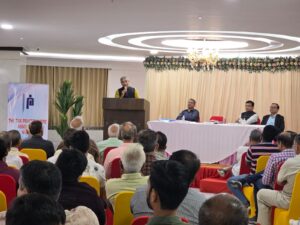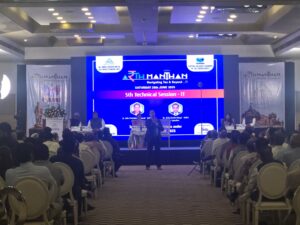GST WEEKLY UPDATE : 6/2023-24 (07.05.2023) By CA Vipul Khandhar

-By CA Vipul Khandhar
- Deferment of Implementation of Time Limit on Reporting Old e-Invoices:
- It has been decided by the competent authority to defer the imposition of time limit of 7 days on reporting old e-invoices on the e-invoice IRP portals for taxpayers with aggregate turnover greater than or equal to 100 crores by three months. In this regard, the link to the previously issued advisory dated 13th April 2023 may be referred at:
- It is to inform you that it has been decided by the Government to impose a time limit on reporting old invoices on the e-invoice IRP portals for taxpayers with AATO greater than or equal to 100 crores.
- To ensure timely compliance, taxpayers in this category will not be allowed to report invoices older than 7 days on the date of reporting.
- Please note that this restriction will apply to the all document types for which IRN is to be generated. Thus, once issued, the credit / Debit note will also have to be reported within 7 days of issue.
- For example, if an invoice has a date of April 1, 2023, it cannot be reported after April 8, 2023. The validation system built into the invoice registration portal will disallow the user from reporting the invoice after the 7-day window. Hence, it is essential for taxpayers to ensure that they report the invoice within the 7-day window provided by the new time limit.
- It is further to clarify that there will be no such reporting restriction on taxpayers with AATO less than 100 crores, as of now.
- In order to provide sufficient time for taxpayers to comply with this requirement, which may require changes to your systems, we propose to implement it from 01.05.2023 onwards.
- The next date of implementation will be shared in due course of time.
- GSTN Advisory for Timely Filing of GST Returns:
- It has been observed that some taxpayers faced difficulty in filing GSTR-3B of March 23’ period on 20th April 2023’. On analysing the reasons, it was noted that large number of tax payers attempted to file GSTR-3B returns in the afternoon of the last day (20.05 lakhs GSTR-3B returns were filed on that day). This resulted in a waiting queue on GST system causing inconvenience to some of the taxpayers.
- Around 45% of the returns filed on 20th April, 23’ were either NIL returns (no tax liability and no ITC availment) or were such returns where no tax was paid in cash. These returns could easily have been filed earlier. Further, it is suggested that taxpayers may use SMS filing option to file NIL returns as it would be quicker and a more convenient way to file NIL returns and will also help to reduce queue on the GST system. Taxpayers are therefore advised to file their Form GSTR- 3B well in advance to avoid last day rush.
- It has also been observed that some taxpayers are uploading large number of invoices (viz upto 27 lakhs) of the past period in one GSTR-1 on the due date of filing. Taxpayers are advised to inculcate a month-wise return filing discipline for all the B2B invoices for the month and avoid reporting invoices of the past period in one go, as such behaviour can adversely impact the queue (waiting time) on the GST system.
- It can thus be seen that with better planning of return filing, the difficulty faced by the taxpayers due to last minute rush can be avoided and it would be of help to fellow taxpayers as well. It may also be noted that GSTN has considerably upgraded its infrastructure over a period of time.
3. CBIC issued important guidelines for Special All-India Drive against fake registrations:
The CBIC vide Instruction No. 01/2023-GST dated May 04, 2023 has issued the guidelines for Special All-India Drive against fake registrations.
By Central and State tax authorities was agreed that a nation-wide effort in the form of a Special Drive should be launched on All-India basis to detect such suspicious/ fake registrations and to conduct requisite verification for timely remedial action to prevent any further revenue loss to the Government. It was decided that common guidelines may be issued to ensure uniformity in the action by the field formations and for effective coordination and monitoring of the action taken during this Special Drive. Accordingly, the following guidelines are issued for such concerted action on fake dealers/ fake billers in a mission mode:
(i) Period of Special Drive: A Special All-India Drive may be launched by all Central and State Tax administrations during the period May 16, 2023 to July 15, 2023 to detect suspicious / fake GSTINs and to conduct requisite verification and further remedial action to weed out these fake billers from the GST eco-system and to safeguard Government revenue.
(ii) Identification of fraudulent GSTINs: Based on detailed data analytics and risk parameters, GSTN will identify such fraudulent GSTINs for State and Central Tax authorities. GSTN will share the details of such identified suspicious GSTINs, jurisdiction wise, with the concerned State/ Central Tax administration (through DGARM in case of Central Tax authorities) for initiating verification drive and conducting necessary action subsequently.
Besides, field formations may also supplement this list by data analysis at their own end using various available analytical tools like BIFA, ADVAIT, NIC Prime, E-Way analytics, etc, as well as through human intelligence, Aadhar database, other local learnings and the experience gained through the past detections and modus operandi alerts. GSTN may separately provide a note to the field formations, regarding the tools available in BIFA which may be useful during this drive.
(iii) Information Sharing Mechanism: Successful implementation of the Special Drive would require close coordination amongst the State Tax administrations, and between State and Central tax administrations. For this purpose, a nodal officer shall be appointed immediately by each of the Zonal CGST Zone and State to ensure seamless flow of data and for coordination with GSTN/ DGARM and other Tax administrations. The name, designation, phone number/ mobile number and E-mail Id of such Nodal officer(s) appointed by CGST Zones and States must be shared by the concerned tax authority with GST Council Secretariat within three days of issuance of this letter. GST Council Secretariat will compile the list of the Nodal officers after procuring the details from all the tax administrations and will make the compiled list available to all the tax administrations, as well as GSTN and DGARM immediately.
The Nodal officer of the State/ CGST Zone will ensure that the data received from GSTN/ DGARM/ other tax administrations is made available to the concerned jurisdictional formation within two days positively. The Nodal officer shall also ensure that any cooperation required by other jurisdictions under his control is promptly provided.
(iv) Action to be taken by field formations: On receipt of data from GSTN/DGARM through the Nodal Officer, a time bound exercise of verification of the suspicious GSTINs shall be undertaken by the concerned jurisdictional tax officer(s). If, after detailed verification, it is found that the taxpayer is non-existent and fictitious, then the tax officer may immediately initiate action for suspension and cancellation of the registration of the said taxpayer in accordance with the provisions of section 29 of CGST Act, read with the rules thereof.
Further, the matter may also be examined for blocking of input tax credit in Electronic Credit Ledger as per the provisions of Rule 86A of CGST Rules without any delay. Additionally, the details of the recipients to whom the input tax credit has been passed by such non-existing taxpayer may be identified through the details furnished in FORM GSTR-1 by the said taxpayer. Where the recipient GSTIN pertains to the jurisdiction of the said tax authority itself, suitable action may be initiated for demand and recovery of the input tax credit wrongly availed by such recipient on the basis of invoice issued by the said non-existing supplier, without underlying supply of goods or services or both. In cases, where the recipient GSTIN pertains to a different tax jurisdiction, the details of the case along with the relevant documents/ evidences, may be sent to the concerned tax authority, as early as possible, in the format enclosed as Annexure-B, through the Nodal Officer referred in para (ii) above.
Action may also be taken to identify the masterminds/ beneficiaries behind such fake GSTIN for further action, where ever required, and also for recovery of Government dues and/ or provisional attachment of property/ bank accounts, etc. as per provisions of section 83 of CGST Act. Further, during the investigation/ verification, if any linked suspicious GSTIN is detected, similar action may be taken/ initiated in respect of the same.
(v) Feedback and Reporting Mechanism: An action taken report will be provided by each of the State as well as CGST Zones to GST Council Secretariat on weekly basis on the first working day after completion of the week in the format enclosed as Annexure-A. If any novel modus operandi is detected during the verification/ investigation, the same may also be indicated in the said action taken report. On conclusion of the drive, GSTIN-wise feedback on the result of verification of the shared suspicious GSTINs, will be provided by the field formations to GSTN/ DGARM, as per the format enclosed in Annexure-C.
(vi) National Coordination Committee: A National Coordination Committee headed by Member [GST], CBIC and including Principal Chief Commissioners/ Chief Commissioners Delhi and Bhopal CGST Zones and Chief Commissioners/ Commissioners of State Tax of Gujarat, West Bengal and Telangana shall monitor the progress of this special drive. National Coordination Committee will meet periodically for this purpose. GST Council Secretariat will act as the secretariat of this National Coordination Committee. The Committee will also be assisted by GSTN and Principal Commissioner, GST Policy Wing, CBIC.
GST Council Secretariat will compile the reports received from various formations and make it available to the National Coordination Committee immediately. The unique modus operandi found during this special drive will be compiled by GST Council Secretariat and presented before National Coordination Committee, which will be subsequently shared with Central and State Tax administrations across the country.
These guidelines are being issued as per the decision of the National Coordination Committee.
- AAR & Judicial Decisions:
(i) AAR On No GST exemption on accommodation to pilgrims outside religious place by charitable trust:
(Applicant – Nandini Ashram Trust)
A charitable trust providing accommodation to pilgrims visiting Ambaji Temple in a building located outside the boundary of the religious place will not get GST exemption, rules Gujarat’s Authority for Advance Rulings (GAAR).
AAR has highlighted relevant paragraph of GST flyer relating to GST on Charitable and Religious Trusts which makes it clear that income from charitable activities such as public health, advancement of spirituality, yoga, advancement of educational programs or skill development and preservation of environment, including watershed, forests and wildlife are exempted.
“There could be many services provided by charitable and religious trust which are not considered as charitable activities and hence such services come under GST net. The indicative list of such services includes renting of premises by such entities, grant of sponsorship and advertising rights during conduct of events/functions etc.,” the bench said.
It highlighted that under chapter 39 of the GST flyer, relating to GST on charitable and religious trusts, it is clarified that law gives a limited exemption to renting of only religious precincts or a religious place meant for general public by the entity registered under the lncome Tax Act.
The term “religious place” means a place which is primarily meant for conduct of prayers or worship pertaining to a religion, meditation, or spirituality. Dictionary meaning of “precincts” is an area within the walls or perceived boundaries of the particular building or place, an enclosed or clearly defined area of ground around a cathedral, church, temple, etc.
Disclaimer:
This publication contains information for general guidance only. It is not intended to address the circumstances of any particular individual or entity. Although the best of endeavour has been made to provide the provisions in a simpler and accurate form, there is no substitute to detailed research with regard to the specific situation of a particular individual or entity. We do not accept any responsibility for loss incurred by any person for acting or refraining to act as a result of any matter in this publication.
(Author is a well known Chartered Accountant practicing at Ahmedabad)




